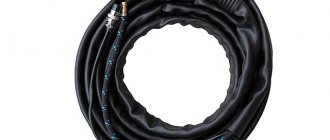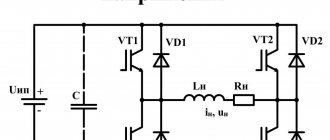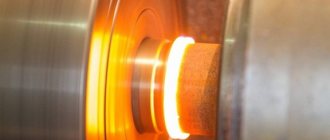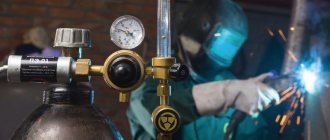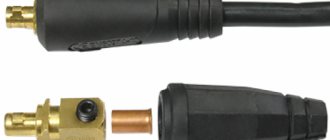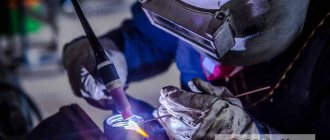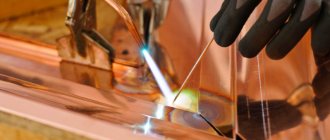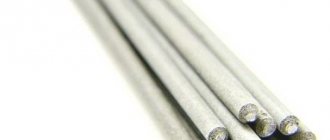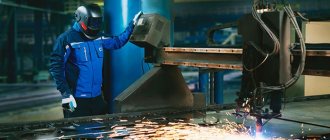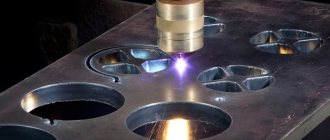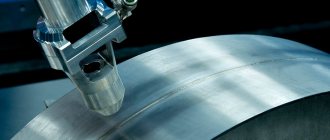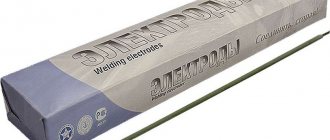The use of acetylene in welding is one of the oldest methods of obtaining a high-quality aesthetic seam. Using this method, you can weld any metals, including ferrous and non-ferrous. You don't even need to use electricity to do it! In short, this is an extremely interesting method of joining homogeneous and dissimilar metals.
In this article we will briefly describe what acetylene welding is, what are the advantages and disadvantages of this technology, and what features should be taken into account in order to obtain the highest quality weld.
Advantages
Why acetylene is the main gas in gas welding of metals? Its combustion temperature exceeds the melting point of steel and other materials. With a highly qualified gas welder, the benefit of acetylene welding is high productivity at low costs for gas and materials. We'll look at the rest of the pros and cons below.
The main advantage of oxy-acetylene welding is mobility and control over welding work. There are other advantages:
- When using acetylene welding, cylinders are easily transported on a trolley. It is convenient to weld a fixed seam at a short distance from the wall. In this case, there is no need to make an operational joint;
- Using a gas torch, you can permanently join metals with different melt temperatures. By adjusting the strength and type of flame, you can achieve optimal conditions for acetylene welding;
- when welding parts of small thickness made of structural steel, copper, cast iron, brass, the acetylene method is indispensable;
- You can improve the quality of the weld by using alloy steel wire or other additives.
By adjusting the heating temperature, severe deformation of the structure and joint can be prevented. At the same time, the optimal speed of welding metals is achieved.
Calcium carbide as a “fuel” for welding.
As mentioned above, when welding, carbide reacts actively with water, releasing a huge amount of heat and acetylene gas. This feature complicates the storage of carbide, so to preserve it, the substance is placed in sealed roofing steel tanks with a capacity of 100 and 130 kilograms. Since carbide releases highly flammable acetylene, it is vital to avoid sparks or open flames when opening these cans.
Calcium carbide dust - particles up to 2 millimeters - is not suitable for use, since it dissolves almost immediately in water and at the same time, the likelihood increases that the use of such a composition will lead to an explosion of the entire cylinder.
For the curious, one kilogram of calcium carbide, depending on the purity and size of the pieces, upon contact with water can release more than 250 dm 3 of acetylene!
Calcium carbide is actively used during gas welding and cutting. When burned with oxygen, acetylene can reach a highest melting point of up to 3150 degrees Celsius, which makes it indispensable when working with refractory metals, because welding or cutting requires a temperature twice the melting degree of the metal itself.
For safe use, acetylene is produced in special generators (Fig. 2) based on calcium carbide or natural gas, oil and coal.
The second method of producing acetylene from natural gas, oil and coal is cheaper than using calcium carbide, by about 30 - 40%.
Flaws
But the acetylene type of welding also has some disadvantages. These include:
- when heated, a large area is formed with changes in the properties of the material, therefore acetylene welding is not used in mechanical engineering;
- when connecting parts with a thickness of more than 5 mm, it is better to replace gas welding with manual or semi-automatic electric welding;
- high carbon steel connection not for oxy-acetylene welding;
- when joining with an overlap, the metal will be significantly deformed, and areas with significant stress will form in it;
- requires increased costs for materials and equipment compared to electric arc welding.
The main disadvantage is the high explosion hazard. But much of this depends on the human factor.
Failure to comply with safety rules and incorrect actions during a kickback are the main mistakes that lead to accidents. When working with acetylene, the welder must have skills above those that are sufficient for semi-automatic and automatic welding.
The acetylene welding method is most suitable for butt joints of parts. And the quality of the seam directly depends on the quality and purity of acetylene and oxygen.
Despite all the disadvantages and high explosion hazard, this type is the main one for welding thin-walled parts and some non-ferrous materials. To this you can add the fullness and neatness of the seam.
An electric arc welding joint cannot be as beautiful and reliable as a gas welding joint, especially with a non-rotating joint.
Classification of acetylene generators
According to GOST 5190, classification of acetylene generators
can occur according to the following parameters: acetylene pressure, productivity, method of application, principle of operation.
1. Based on the pressure of the acetylene produced, there are low pressure generators - up to 0.01 MPa, medium pressure - from 0.07 MPa to 0.15 MPa and high pressure - over 0.15 MPa.
2. In terms of productivity, existing acetylene generators synthesize from 0.3 to 160 m3/h of acetylene.
3. According to the method of application, generators are divided into mobile and stationary. The productivity of mobile generators is 0.3-3m3/h, and the productivity of stationary generators is 5-160m3/h.
4. According to the principle of operation, acetylene generators are classified into those operating according to the following principles: a) HF - carbide into water; b) VK - water on carbide with a “wet” process option; c) VK - water on carbide with a “dry” process option; d) BB - displacement of water; e) PC is a combined principle, combining the “water on carbide” and “water displacement” schemes. The design and operation of acetylene generators depends on the principle of operation.
Tools and materials
For acetylene welding you will need quite accessible and relatively inexpensive equipment. Previously, gas generators were used to produce gas, but now bottled acetylene is more common.
The cylinder is painted white. Bottled oxygen is used to maintain combustion. As a rule, they are transported on special trolleys.
Depending on the thickness of the metal being welded, several sizes of torch and nozzle are used. The smallest size a burner can have is zero, and the largest is fifth.
If strong heating of thick metal is necessary, the largest number with a hole is used, allowing the gas mixture to be supplied into the weld pool and ensuring normal heating of the joint.
Hoses with acetylene and oxygen are suitable for the burner. Attached using a threaded connection.
Reducers allow you to regulate the gas supply and reduce the pressure of the gas coming from the cylinder. The pressure in the oxygen cylinder is about 150 atm. In addition, the gearboxes protect the cylinder from blowback.
Depending on the type of material being welded, the filler wire can be made of steel or other metals with the addition of alloying additives. They improve the quality of the seam. For acetylene welding of steel water pipes, beaten electrodes for manual electric welding are used, but this is a more expensive option.
a brief description of
Acetylene welding is an ancient method of welding metal parts. Acetylene is obtained by combining calcium carbide and water. Previously, mixing was done manually using a special generator. Additionally, an oxygen cylinder, hoses, and a burner were used.
The main feature of acetylene as a chemical element is the structure of its molecule C2H2. It has two weak hydrogen bonds and a high-energy triple bond between carbon atoms. It is these properties that made it possible to use gas in welding technology. It produces high-quality and durable connections of structures made of different types of metal.
However, this technology had a big drawback - the use of a generator and manual mixing of acetylene. This measure was complex and had to be performed before each welding. But not everything is so bad, there were still positive aspects, the remaining gas was later drained, they were used again.
However, after some time, welding with acetylene and oxygen began to be carried out using special cylinders with the necessary gas. For this reason, it is no longer necessary to manually combine calcium carbide and water.
Technological process of gas welding
The work process begins with opening the valves on the cylinders and adjusting the gas pressure using reducers. The optimal gas pressure value is 2 atmospheres. At higher pressures, flame adjustment may be difficult.
Open the acetylene supply valve on the burner and ignite the gas. Then, gradually opening the oxygen valve, we adjust the flame. For welding ferrous metals, a neutral torch flame is most often used. The torch itself consists of three parts, clearly visible to the naked eye.
Blue color with a slight greenish tint has a core that is located inside the flame.
Next comes the working area, which is responsible for the heating and quality of the seam during the acetylene welding process. This is a reducing flame and is typically light blue in color.
The largest part is the burner torch. It is responsible for heating the metal.
To set a neutral flame, you need to lean the burner against any metal surface and adjust it with the gas supply valves. The core does not have to be very large, and the reduction flame is adjusted to a specific color.
First, the torch size is set. This is done by injecting acetylene. Then gradually increasing the oxygen supply, we achieve a normal flame.
In this case, you should not make a very powerful flame. It will increase not only the speed of acetylene welding, but also increase the number of burns and undercuts of the seam. Therefore, adjustment is one of the main operations that facilitates welding work.
You cannot display a long and orange torch color. Such combustion will reduce the quality of the weld by introducing excess carbon into the weld pool.
Basic methods of maintaining the torch and filler material
Specialists use two ways of holding the instrument: “pull” and “pull”.
When driven from yourself, a wire is located in front of the burner. This method is used when welding structures of large thickness. In this case, the molten metal of the parts and additives simultaneously fills the weld pool.
This method requires the welder to ensure uniform mixing of the base and filler metal. If there is insufficient amount of wire melt, the seam becomes weakened.
With the “pull” acetylene welding method, the torch comes first, and when the base metal is melted, metal from the wire is added to the bath. Here you need to position the burner correctly.
It should go at an acute angle in relation to the parts. This method is the simplest. You need to heat the metal, remove a drop from the wire and stretch it along the seam. According to this principle, the seam leg is formed.
For greater convenience and to prevent the formation of burns, the burner is moved either in a crescent or in a circular motion.
A major role in the quality of the connection is played by the correct joining of parts and the absence of large gaps when welding thin sheets or pipes. It should be remembered that before acetylene welding, the parts must be grabbed in several places. On small diameter pipes, tacks are made after about 1200.
The performance of welding work is also influenced by the characteristics of the metal being welded.
Mode selection
To increase the quality of the seam and its tightness, depending on the material, you need to know some secrets of professional gas welders.
High-carbon steels are welded very rarely using acetylene welding. But low-carbon structural steels are the area of application for gas welding.
In this case, good results are achieved in any spatial position of the seam. The average combustion power should not exceed 120 cubic decimeters per hour.
The best way is to operate the burner away from you. The additive must be used from low-carbon steel, but electrodes for electric welding can be beaten. When the metal melts, silicon and manganese come out of it and a coarse-grained steel structure is formed. Wire made of ST.2, with a silicon content of less than 1% and manganese of 1.1%, will provide a homogeneous weld in structure.
Alloy steel is not recommended to be welded using the acetylene method. With strong heating, parts become deformed, so when welding some grades of steel, the following recommendations must be followed.
Fluxes must be used to join low-alloy steels. Welding with acetylene is carried out with a normal flame. The torch should be operated at low power with a low flame when welding steel with high chromium and nickel content.
To join heat-resistant steels, an additive containing 21% nickel and 25% chromium is used. It will be easier to weld steel with high corrosion resistance if you use wire containing nickel, chromium and molybdenum.
Peculiarities
Before starting acetylene welding, it is worth studying the technology of this process. There are some important features on which the quality and reliability of welded joints depends.
This type has become famous and in demand due to the simple production of acetylene gas and its low cost. The qualitative characteristics of the connection depend on three main factors - flame power, welding angle, and filler wire diameter.
For this reason, it is worth considering in more detail the main features of acetylene technology:
- The flame power of the gas burner is selected in accordance with the properties of the metal that will be welded.
- There is a certain rule that you should rely on when choosing power parameters of the flame. A thick product has high thermal conductivity and melting point, which means that it will require high flame power. But with thin products it is done differently. However, it is worth remembering that the greater the flame power, the higher the gas consumption.
- The welding angle indicators depend on the thickness of the part being welded. For elements with a thickness of 1 to 155 mm, an angle of 10 to 80 degrees is recommended.
- The angle of inclination must be increased depending on the thickness of the workpiece.
- In order for the product to heat up evenly, at the initial stage of the welding process the torch must be held at an angle of 90 degrees. It does not matter what thickness the part is.
- It is imperative to take into account that the quality of the connection is influenced by the parameters of the diameter of the filler wire. The diameter of this element must also be selected in accordance with the thickness of the metal product.
- Welders advise using a tricky rule when calculating the diameter of the wire - first you need to find out the thickness of the part in mm, then it is divided in half. 1 mm is added to the result obtained, this will be the indicator of the diameter of the filler wire.
- The torch for welding with acetylene can be driven from itself or towards itself. If the welder leads it away from himself, then the torch must move first, and then the filler wire must follow it. This will allow the metal to completely heat up and form a weld pool.
Working with cast iron, copper and brass
Before welding cast iron, it is necessary to warm up the joint and only then carry out the work. Otherwise, white cast iron is formed in the structure of the base metal, and the joint becomes brittle. The work is carried out with a normal flame.
Welding of copper parts is carried out without breaks and preliminary tacks. There is no gap between the parts. Copper is a very fluid material when heated and is a very thermally conductive material. Therefore, it is necessary to set a more powerful burner flame. It is better to carry out acetylene welding under a layer of flux to prevent oxidation of the joint.
Welding brass using acetylene and oxygen is the best option for this material. The melt temperature should not exceed 9000, while the zinc does not completely evaporate. Thanks to acetylene welding, a reliable seam is formed, removing 25% of this metal from the weld pool.
It is necessary to maintain a low content of combustible gas in the mixture, this will allow zinc to evaporate in the required volume. For best results, it is necessary to use fluxes and a high-quality additive. Using gas welding, you can also weld bronze parts and other metals.
